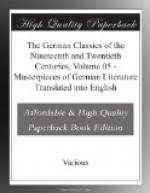Later in life, Brentano returned to the Roman Church into which he had been baptized as a child, and gradually withdrew from literary activity. Long before his death in 1842, he had renounced his earlier life as wicked and abhorrent, and had given himself over entirely to the Church. But his career with its constant wanderings, its lack of permanency of occupation, of family ties, and of a real home, his inability to grow old, his inner unreality, his excessive productivity-in short, all that is incomplete, over-stimulated, destructive of self, make him the most typical figure of the later Romantic group.
Ludwig Achim von Arnim (1781-1831) is by no means so bizarre a figure. Born in Berlin of a noble family, he inherited a peculiar patriotism and his love of culture, and developed these without the eccentricities which characterized his brother-in-law. The main influences of his early years were Goethe and Jena, but, as a direct inspiration, Tieck must also be mentioned. Arnim’s early works lie largely in the field of natural science, especially in physics. He had little of Brentano’s lyric gift; indeed, his poems, where not wooden, are often merely reminiscent. They show, too, in an unusual degree, the ability to adapt himself to another’s mood and assimilate it—that which the Germans call “Nachempfinden,” a quality which stood him in excellent stead in his work on The Boy’s Magic Horn.
The drama Halle and Jerusalem (1810) is an amalgamation of the story of Cardenio and Celinde used by Gryphius and Immermann, with the story of the Wandering Jew. The first four acts take place in Halle where Cardenio is a teacher and where he is living in incestuous relation with Olympia. He is a Faust-nature and his father is Ahasuerus. The fifth act is taken up with a pilgrimage to Jerusalem where the romantic fates of the characters are decided. The play abounds in contemporary satire and, as in all of Arnim’s work, there is distinct emphasis on action, the goal of human endeavor.
Arnim’s prose is better than his verse. Soon, in The Guardians of the Crown (1817; volume 2 unfinished and published in his literary remains, 1854), he strikes an individual note. This novel is one of the best products of German Romanticism. The Guardians are a mysterious secret organization who guard the imperial crown in a fairy castle and are favorable to the ancient house of Hohenstaufen but inimical to the ruling Habsburgs. The basis is the newly awakening ideal of German unity but Arnim fails to express this clearly, and the concluding motif, that Germany’s crown is to be spiritually won, resolves the whole into a frosty allegory. The progress of the story is, however, extremely interesting; the whole spacious and varied scene of medieval life is there, and as Tieck and Wackenroder discovered Nuremberg, and Brentano the Rhine, so Arnim may be said to have shown in its full activity the Ghibelline city of Waiblingen. It is, to be sure, a Romantic




